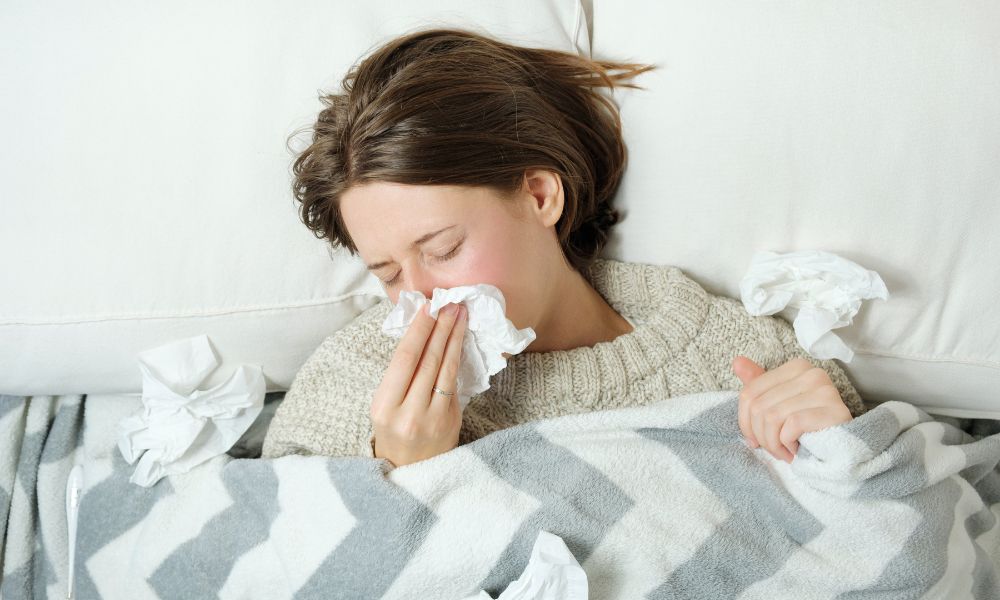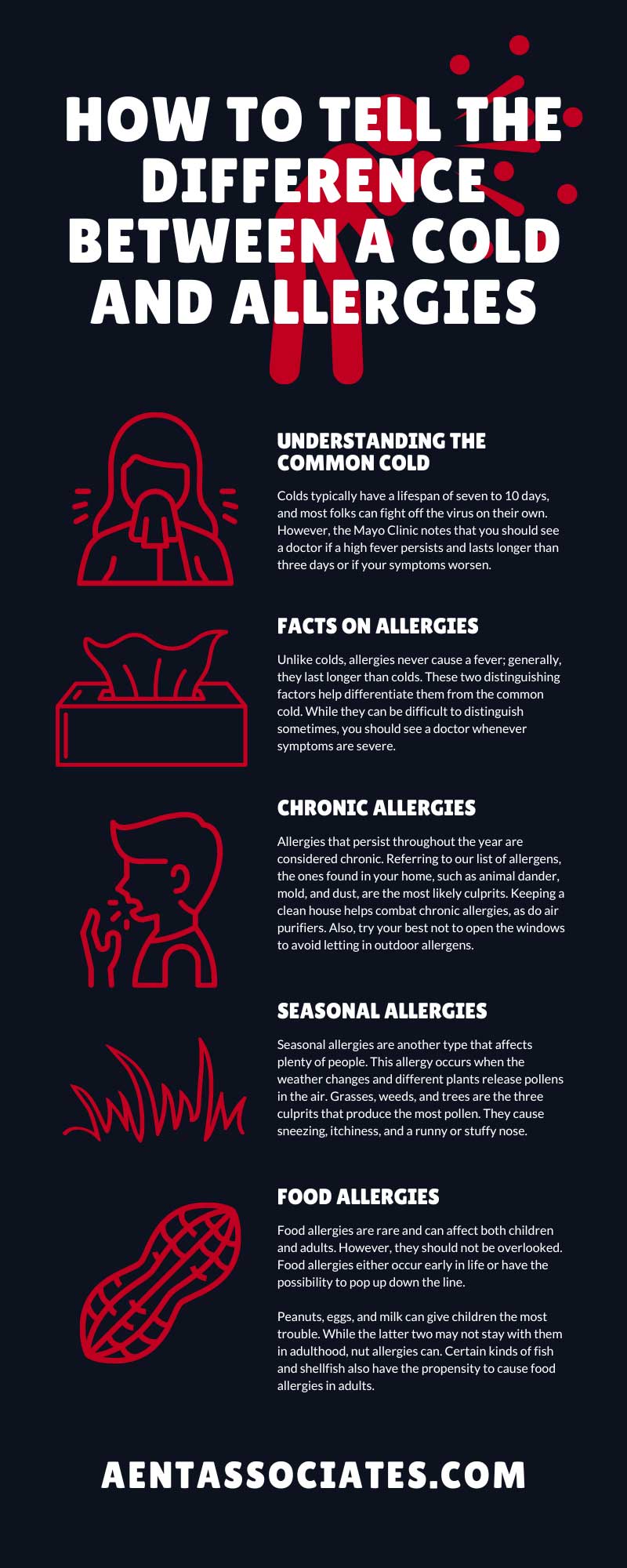
Autumn is upon us. Our kids are back in school, and there are fall festivities aplenty. With the leaves changing and the cooler temperatures, Texas is beautiful this time of year, but some folks don’t feel their best. The change of seasons raises this question: Do I have a cold or allergies?
At Allergy & ENT Associates, we want to help you understand how to tell the difference between a cold and allergies. You will discover the best treatment options to pursue by understanding how the two differ from one another. When armed with a clean bill of health, you can get back to enjoying the fall season in the Lone Star State.
Understanding the Common Cold
We have all experienced the common cold, especially in the fall or winter. The Mayo Clinic defines the common cold as “a viral infection of your nose and throat (upper respiratory tract).” While cold symptoms can overlap with allergies, the fundamental difference is the viral factor. A virus won’t make you suffer from allergies, which we will delve further into later.
Colds typically have a lifespan of seven to 10 days, and most folks can fight off the virus on their own. However, the Mayo Clinic notes that you should see a doctor if a high fever persists and lasts longer than three days or if your symptoms worsen.
Symptoms
The following symptoms often go hand in hand with colds:
- Cough
- Fever
- Congestion
- Runny nose
- Achiness
- Headache
- Sore throat
- Drowsiness
Plenty of rest and fluids get you back on your feet when you’re suffering from the common cold. Over-the-counter medicines, like acetaminophen or ibuprofen, help manage symptoms like achiness, headaches, and fevers. Nasal sprays work well for combating congestion.
Now that we’ve learned about the basics of the common cold let’s look at allergies.
Facts on Allergies
As mentioned in the previous section, an allergy is not a virus. The Mayo Clinic says, “Allergies occur when your immune system reacts to a foreign substance — such as pollen, bee venom, or pet dander — or a food that doesn’t cause a reaction in most people.” Your body perceives the substance as a threat. This response causes those symptoms we know and dread.
Unlike colds, allergies never cause a fever; generally, they last longer than colds. These two distinguishing factors help differentiate them from the common cold. While they can be difficult to distinguish sometimes, you should see a doctor whenever symptoms are severe.
Types of Allergens
Millions of people suffer from allergies caused by a variety of allergens. We’ve found that these offenders prompt allergy attacks year-round:
- Animal dander
- Pollen
- Mold
- Food
- Dust
- Insect sting
- Medications
- Mold
- Latex
With folks being allergic to so many things, it’s no wonder there are different types ranging from seasonal to chronic allergies. Let’s explore the different kinds of allergies to figure out how to treat them.
Chronic Allergies
Allergies that persist throughout the year are considered chronic. Referring to our list of allergens, the ones found in your home, such as animal dander, mold, and dust, are the most likely culprits. Keeping a clean house helps combat chronic allergies, as do air purifiers. Also, try your best not to open the windows to avoid letting in outdoor allergens.
If cleanliness fails to provide relief, you should seek help from our specialists as soon as possible. Signs of chronic allergies not being treated effectively include:
- Over-the-counter medications no longer help treat symptoms
- Suffering from allergy symptoms, such as fatigue and a stuffy or runny nose
- Experiencing snoring that disturbs partner, which may be a sign of sleep apnea
- Severe asthma attacks that make it difficult to breathe
- Frequent sinus infections
Seasonal Allergies
Seasonal allergies are another type that affects plenty of people. This allergy occurs when the weather changes and different plants release pollens in the air. Grasses, weeds, and trees are the three culprits that produce the most pollen. They cause sneezing, itchiness, and a runny or stuffy nose.
During the fall, weed pollen is the most prominent in Texas and the United States. Ragweed is the number one offender. Since it grows almost everywhere, it’s difficult to escape.
Pay Attention to Pollen Counts
Pollen counts can help determine what outdoor allergens give you the most trouble. They provide a detailed breakdown of what pollens are present daily. This breakdown includes the quantities of pollens and if they come from trees, weeds, and grasses. By keeping this in mind, you’ll start to learn what outdoor allergens give you symptoms.
Do your best to take allergy medicine or stay inside on days when the pollen count is high. Using saline solutions is also another option to clear your sinuses. This home remedy helps when an allergy affects your nasal passages. As we mentioned with chronic allergies, keeping the home clean, using air purifiers, and avoiding opening windows goes a long way in fighting seasonal allergies.
Food Allergies
Food allergies are rare and can affect both children and adults. However, they should not be overlooked. Food allergies either occur early in life or have the possibility to pop up down the line.
Peanuts, eggs, and milk can give children the most trouble. While the latter two may not stay with them in adulthood, nut allergies can. Certain kinds of fish and shellfish also have the propensity to cause food allergies in adults.
Symptoms
Signs of a food allergy range from mild to severe. Be on the lookout for:
- Hives
- Swelling, particularly of the lips, throat, tongue, or face
- Diarrhea
- Anaphylaxis
Anaphylaxis is dangerous and should be handled by medical professionals immediately. Warning signs of this include:
- Shock
- Difficulty breathing
- Passing out
- Rash
- Nausea and vomiting
Take care to prevent food allergies. Anaphylaxis can also occur from an insect sting. Our allergy specialists in the Houston area can test for food allergies and see if you’re allergic to any venoms to help you avoid an emergency.
Let’s recap: the common cold can mask itself as allergies due to overlapping symptoms. Remember that colds cause fevers and stem from a virus. Keep this in mind to tell the difference between a cold and allergies. In either case, please consult your doctor if you suffer from severe symptoms.
Allergy & ENT Associates is here to help you. Visit us at our Sugar Land location today, or schedule an appointment at one of our other 18 locations.




